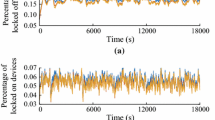Abstract
Primary frequency control, also known as primary frequency response or droop, is one of the essential ancillary services guaranteeing stable operation of any power system. Provision of primary and secondary frequency control reserves creates high costs to the system operator. Demand Response, that is an automatic contribution by flexible loads, may provide some of the reserves needed for grid operation at lower cost than traditional power plants. An improved algorithm for primary frequency control provision with refrigerators is described. This algorithm (1) prevents synchronization of participating loads, and (2) guarantees continuous frequency support. A simulation based on a dynamic two-area system resembling the central European grid shows the performance of the algorithm, compliance with refrigerator temperature limits and improvements in power system frequency response after a contingency.





Similar content being viewed by others
References
Kupzog F, Palensky P (2007) Wide-area control system for balance-energy provision by energy consumers. In: 7th IFAC International Conference on Fieldbuses & Networks in Industrial & Embedded Systems (FeT’07), Toulouse, Nov. 2007, pp 337–345
Short JA, Infield DG, Freris LL (2007) Stabilization of grid frequency through dynamic demand control. IEEE Trans Power Syst 22(3):1284–1293
Angeli D, Kountouriotis P-A (2012) A stochastic approach to “dynamic-demand” refrigerator control. IEEE Trans Control Syst Technol 20(3):581–592
Borsche T, Oldewurtel F, Andersson G (2013) Minimizing Communication Cost for Demand Response using State Estimation. In: IEEE PES PowerTech, Grenoble, Jun. 2013
Borsche T, Ulbig A, Koller M, Andersson G (2013) Power and Energy Capacity Requirements of Storages Providing Frequency Control Reserves. In: IEEE PES General Meeting, Vancouver, Jul. 2013
Stadler M, Krause W, Sonnenschein M, Vogel U (2009) Modelling and evaluation of control schemes for enhancing load shift of electricity demand for cooling devices. Environ Model Softw 24(2):285–295
Constantopoulos P, Schweppe F, Larson R (1991) Estia: a real-time consumer control scheme for space conditioning usage under spot electricity pricing. Comput Oper Res 18(8):751–765
Molina-García A, Bouffard F, Kirschen DS (2011) Decentralized demand-side contribution to primary frequency control. IEEE Trans Power Syst 26(1):411–419
Xu Z, Østergaard J, Togeby M (2011) Demand as frequency controlled reserve. IEEE Trans Power Syst 26(3):1062–1071
Kundur P (1994) Power System Stability and Control, 1st edn. In: Bau NJ, Lauby MG (eds). McGraw-Hill Professional, New York
Weissbach T, Welfonder E (2008) Improvement of the Performance of Scheduled Stepwise Power Programme Changes within the European Power System. In: Proceedings of the 17th IFAC World Congress, Seoul, Jul. 2008, pp 11972–11977
Koch S, Zima M, Andersson G (2009) Potentials and applications of coordinated groups of thermal household appliances for power system control purposes. In: 2009 IEEE PES/IAS Conference on Sustainable Alternative Energy (SAE), Valencia, Sep. 2009
Aunedi M, Kountouriotis P-A, Calderon JEO, Angeli D, Strbac G (2013) Economic and environmental benefits of dynamic demand in providing frequency regulation. IEEE Trans Smart Grid 4(4):2036–2048
Author information
Authors and Affiliations
Corresponding author
Additional information
This research is part of the HeatReserves project funded by the nanoTera foundation.
Rights and permissions
About this article
Cite this article
Borsche, T., Markovic, U. & Andersson, G. A new algorithm for primary frequency control with cooling appliances. Comput Sci Res Dev 31, 89–95 (2016). https://doi.org/10.1007/s00450-014-0289-1
Published:
Issue Date:
DOI: https://doi.org/10.1007/s00450-014-0289-1




